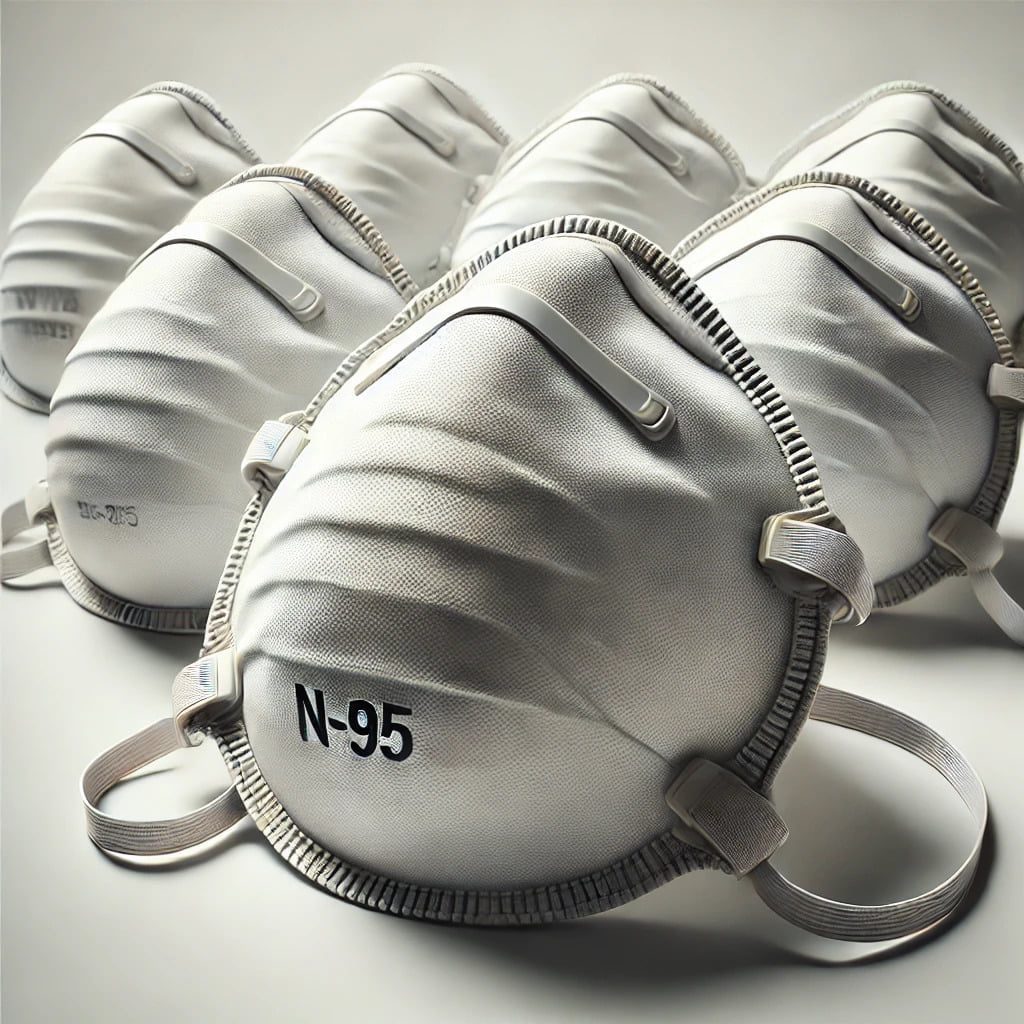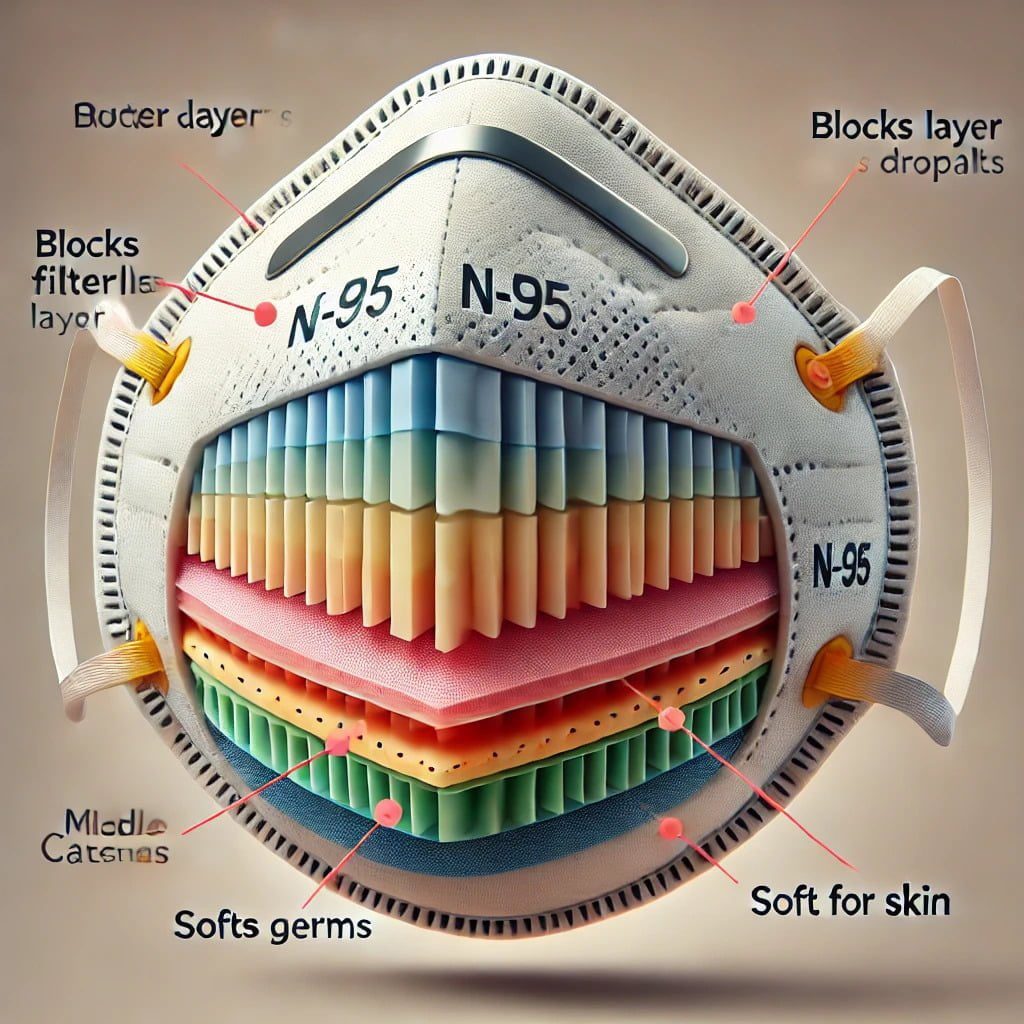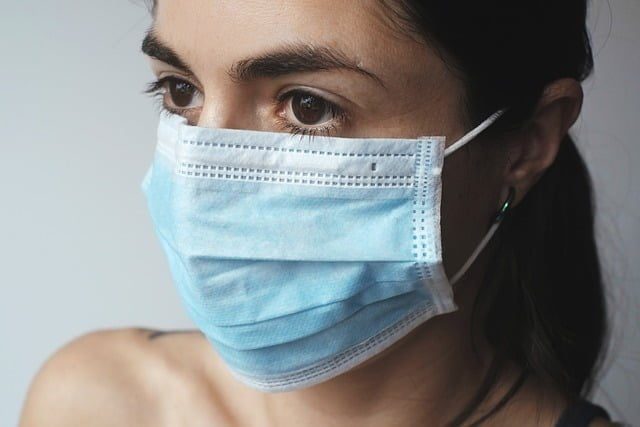
Personal Introduction
As a lifelong Libertarian and the author of this article, I consider mandates such as mask-wearing to be akin to seatbelt laws, or regulations against any behavior that is not immediately life-threatening. However, common sense should prevail in public health, especially during crises like the COVID-19 pandemic. We must educate ourselves in order to make sound decisions with less interference, whether that interference is from governments, large corporations, or politicians exploiting the poorly educated by misrepresenting basic science. In this article, we will address some of the misinformation that has circulated regarding the role of N95 respirators. Anti-mask propaganda must be countered with real science. Thankfully, this is quite easily done by anyone who has taken an 8th grade science class.
The Efficacy of N95 Masks Against COVID-19: The Science
The global fight against COVID-19 has spotlighted the crucial role of N95 respirators. Understanding how these masks work provides clarity on their effectiveness and dispels prevalent myths. Let’s delve into the science behind each of their key functional aspects. N95 masks boast a filtration efficiency of 95% or higher, by targeting the larger droplets containing COVID virions. Recognized globally by health authorities like the CDC (US), PHAC (Canada), and others, there’s unanimous agreement on their effectiveness in curbing COVID-19 spread. No reputable health organization has opposed their use.
1. Filtration of Larger Particles
N95 masks are engineered to filter out 95% of particles that are 0.3 microns or larger. However, their efficacy extends beyond just the size filtration:
- Particle Attachment: A significant portion of the virus-laden particles are expelled in mask droplets, which are generally larger than 5 microns. The Centers for Disease Control and Prevention (CDC) explains that these droplets are the primary means of COVID-19 transmission.
- Effectiveness: While the exact percentage varies, studies like this one from the Journal of Aerosol Science indicate that N95 masks are highly effective in capturing these larger particles, thereby significantly reducing the transmission of virus-laden droplets.
2. N95 Respirator Electrostatic Charge
One of the less discussed but vital features of N95 masks is their electrostatic nature:
- How It Works: The fibers in N95 masks are manufactured to have an electrostatic charge. As explained by the National Institute for Occupational Safety and Health (NIOSH), this charge enhances the filtration efficiency by attracting airborne particles.
- Mechanism of Attraction: This electrostatic attraction ensures that particles smaller than the mask’s physical pore size are still effectively captured, as detailed in research published in ACS Nano.
3. Brownian Motion
Brownian motion plays a subtle yet crucial role in the effectiveness of N95 masks.
- Principle Theory: Brownian motion refers to the random movement of particles suspended in a fluid (like air). This concept, fundamental to physics and explained in resources like Khan Academy’s science lessons, shows that smaller particles move erratically.
- Impact on Filtration: This erratic movement increases the likelihood of small particles, such as virions, colliding with and being captured by the mask fibers. The Journal of Occupational and Environmental Hygiene provides insights into how this motion enhances the filtering efficiency for small particles.
- The Explain it Like I’m Five version: Imagine you have a tiny speck of dust floating in a glass of water. Even though you’re not touching it, you can see it moving around on its own. That’s because invisible tiny things in the water are always bumping into the speck, making it wiggle and move in different directions. It’s like the speck is playing a game of tag with the invisible water molecules, and it can go in any direction because it’s getting bumped from all sides. This wiggling and jiggling of tiny particles is what we call Brownian motion.
Adoption of N95 Respirator Protocols During the Pandemic
Worldwide Adoption and Statistics
The use of N95 masks became widespread globally, with several countries implementing them as a key component of their COVID-19 response strategy. The adoption rate varied, influenced by government policies, public awareness, and availability. For instance, in countries like South Korea and New Zealand, the use of masks in public spaces was almost universal during peak pandemic periods. Contrastingly, in some Western countries, mask usage faced more resistance due to political and cultural factors from the anti-mask propaganda crowd.
Supply and Distribution Challenges
Initially, the high demand for N95 masks led to shortages, affecting healthcare workers and the general public. This prompted efforts to ramp up production and distribution, with companies like 3M significantly increasing their output. Governments also intervened, with measures like the Defense Production Act in the United States, to ensure adequate supply for frontline workers.

Environmental Concerns
An unintended consequence of the mass use of masks has been environmental. The disposable nature of N95 masks has contributed to increased plastic waste. This has sparked discussions and research into more sustainable, biodegradable mask options, while maintaining the same level of protection.
Studies and Scientific Evidence Supporting Mask Use
Research Studies
Numerous studies have validated the effectiveness of masks. A pivotal study published in the journal ‘Science’ demonstrated a significant reduction in COVID-19 transmission rates in areas with mask mandates. Another study in ‘The Lancet’ provided a comprehensive analysis of physical distancing, face masks, and eye protection for preventing person-to-person virus transmission.
Real-world Impact: N95 Respirators versus COVID-19
Beyond laboratory tests, real-world data provided compelling evidence. Countries with high mask compliance saw more effective control and quicker reduction in COVID-19 cases. For example, a study in ‘Health Affairs’ compared the growth rate of COVID-19 before and after mask mandates in 15 states and the District of Columbia, noting a slowdown in daily COVID-19 growth rates after mask mandates.
Meta-Analyses
Meta-analyses, which combine data from multiple studies, have reinforced the effectiveness of masks. These comprehensive reviews have concluded that mask-wearing significantly reduces the risk of transmitting or contracting COVID-19, especially in combination with other preventive measures.

Mask Efficacy against Variants
A prevalent misunderstanding is that masks are less effective against new virus variants. Yet, research consistently indicates that the primary transmission method (respiratory droplets) hasn’t changed, maintaining their effectiveness, cementing the role of N95 respirators.
Oxygen Levels and CO2 Accumulation
Claims that masks significantly reduce oxygen intake or cause harmful CO2 accumulation have been debunked by medical studies. Healthcare professionals, who wear masks for extended periods, have not reported such adverse effects in clinical settings.
Anti-mask Propaganda
Addressing the role of misinformation sources, politicians and the like, it’s crucial to highlight the impact of conspiracy theories and false claims spread by groups like QAnon and Infowars. These narratives have been countered by fact-checking organizations and public health campaigns, emphasizing the need for accurate information in public health.
Long-Term Public Health Policies Post-Pandemic Regarding Mask Usage
Policy Shifts
The COVID-19 pandemic has prompted a reevaluation of public health policies regarding respiratory diseases. Many countries are considering incorporating mask-wearing into their long-term disease prevention strategies, especially during flu seasons or in response to future outbreaks.
Integration with Other Health Measures
Masks are being viewed as part of a broader approach to public health. This includes not only pandemic response but also routine measures against seasonal flu and other respiratory infections. The emphasis is on a combination of vaccination, personal hygiene, and mask-wearing in high-risk situations.
Preparedness for Future Pandemics
The pandemic has highlighted the need for preparedness in face of future health crises. Policies are being formulated to ensure a ready supply of masks and other protective equipment, alongside plans for rapid deployment in case of future outbreaks.
Impact of Mask-Wearing on Future Respiratory Disease Outbreaks and Pandemic Preparedness
Lessons Learned
The widespread use of masks during the COVID-19 pandemic has provided valuable insights into their role in controlling respiratory infections. These lessons are shaping future strategies for managing outbreaks.
Cultural Shifts
There has been a cultural shift in many societies regarding mask-wearing. Once primarily seen in East Asian countries, it’s becoming more accepted globally as a norm during health crises, potentially leading to more effective responses in future outbreaks.
Research and Innovation
The pandemic has spurred ongoing research into mask technology, focusing on improving comfort, accessibility, and effectiveness. Innovations in mask design and filtration technology are expected to evolve, offering better protection in future health emergencies.
Monitoring Global Adoption of Sustainable Mask Technologies
Tracking Progress in Different Regions
The adoption of sustainable mask technologies varies globally, influenced by factors such as government policies, public awareness, and access to technology. Monitoring these trends can provide insights into the effectiveness of different approaches and identify best practices for widespread adoption.
Case Studies and Success Stories
Documenting case studies where sustainable mask technologies have been successfully implemented can serve as valuable examples for other regions. These stories can highlight innovative materials, effective recycling programs, and community-driven initiatives that have made a positive environmental impact.
Collaboration Between Sectors
Observing collaborations between governments, private sectors, and environmental organizations offers a comprehensive view of the efforts being made. These partnerships are crucial for the development and distribution of sustainable mask options on a larger scale.
Effectiveness of Public Health Policies Involving Mask Usage
Impact on Seasonal Flu Rates
Analyzing data on seasonal flu rates post-pandemic can reveal the effectiveness of public health policies that include mask-wearing. Comparing these rates with historical data can provide a quantitative measure of the impact of these policies.
Public Compliance and Response
Assessing public compliance with mask policies is essential for understanding their effectiveness. Surveys, interviews, and observational studies can provide insights into public attitudes and behaviors regarding mask-wearing in different contexts.
- Policy Adjustments and Updates
Keeping track of how public health policies are adjusted in response to new data and changing circumstances is vital. This includes looking at how authorities balance mask mandates with other preventive measures as the situation evolves.
Emerging Research on Mask Technology and Public Health Implications

Advancements in Filtration and Comfort
Emerging research is likely to focus on enhancing mask filtration efficiency while improving comfort for prolonged use. Innovations that reduce heat, moisture build-up, and skin irritation are of particular interest, especially for healthcare workers.
- Accessibility and Inclusivity
Research into making masks more accessible and inclusive is important. This includes designs for different face shapes, sizes, ensuring that protective measures are effective and equitable for all demographics. Long-term Health Studies
Long-term studies on the health impacts of prolonged mask usage, both positive and negative, are crucial. These studies can inform guidelines and recommendations for future public health strategies.
As we navigate the post-pandemic world, the role of masks, particularly sustainable and innovative designs, remains a key focus in public health. Ongoing monitoring of global trends, assessment of public health policies, and keeping abreast of emerging research are essential for ensuring effective and responsible strategies. The lessons learned from the COVID-19 pandemic will undoubtedly shape our approach to respiratory health and pandemic preparedness for years to come, maintaining the role of N95 respirators.
Conclusion
The N95 respirators’ design and material properties make them highly effective in filtering out harmful particles, including the SARS-CoV-2 virus. By understanding the principles of larger particle filtration, electrostatic charge, and Brownian motion, we can appreciate the science behind these masks. This understanding is crucial in countering misinformation and reinforcing public confidence in these essential protective tools. As we continue to rely on scientific evidence to guide our responses to the pandemic, resources like the World Health Organization (WHO) and Johns Hopkins Coronavirus Resource Center remain invaluable for up-to-date information and further research on COVID-19 and protective measures.
Sarcasm
Before giving readers the homework of checking the bibliography, I would like to thank the groups that support the anti-mask propaganda. Pass on to them the thanks that our families, countrymen and global citizens would, had they not perished.
- QAnon. This is a wide-ranging conspiracy theory that has spread false information about COVID-19, including misinformation about masks and public health measures.
- Infowars. Yes, despite the successful lawsuits against their disinformation, and Alex Jones himself admitting he “just plays a character”, idiots take him seriously.
- Proud Boys: What would any list of wackjob imbeciles be without these gutless, science-free wannabe Klansmen?
- Oath Keepers: Yes, they do still exist, despite their disreputable leader being sentenced to 18 years for his failed attempt at overthrowing Democracy.
- O9A: I won’t elaborate. You know what you did.
*** Bibliography ***
Studies on N95 Respirator Efficiency and Use
- Sinkule, E.J., Powell, J.B., & Goss, F.L. (2013). “Evaluation of N95 Respirator Use with a Surgical Mask Cover: Effects on Breathing Resistance and Inhaled Carbon Dioxide.” Annals of Occupational Hygiene, 57(3), 384. [PubMed] Link – Examines the impact of adding a surgical mask cover on N95 respirator breathing resistance and CO2 levels.
- Roberge, R.J., Bayer, E., Powell, J.B., Coca, A., Roberge, M.R., & Benson, S.M. (2010). “Effect of Exhaled Moisture on Breathing Resistance of N95 Filtering Facepiece Respirators.” Annals of Occupational Hygiene, 54(6), 671. [PubMed] Link – Investigates how moisture from exhalation affects the breathing resistance of N95 respirators.
- Lee, H.P., & Wang, D.Y. (2011). “Objective Assessment of Increase in Breathing Resistance of N95 Respirators on Human Subjects.” Annals of Occupational Hygiene, 55(8), 917. [PubMed] Link – Studies the increase in breathing resistance when wearing N95 respirators.
- Roberge, R.J., Kim, J.H., & Benson, S. (2012). “N95 Filtering Facepiece Respirator Deadspace Temperature and Humidity.” Journal of Occupational and Environmental Hygiene, 9(3), 166. [PubMed] Link – Analyzes the temperature and humidity within the deadspace of N95 respirators.
Impacts on Health and Comfort
- Lim, E., Seet, R., Lee, K.H., Wilder-Smith, E., Chuah, B., & Ong, B. (2006). “Headaches and the N95 Face-Mask Amongst Healthcare Providers.” Acta Neurologica Scandinavica, 113(3), 199–202. [PMC Free Article] [PubMed] Link – Explores the occurrence of headaches among healthcare providers using N95 masks.
- Li, Y., Tokura, H., Guo, Y., Wong, A., Wong, T., Chung, J., et al. (2005). “Effects of Wearing N95 and Surgical Facemasks on Heart Rate, Thermal Stress, and Subjective Sensations.” International Archives of Occupational and Environmental Health, 78(6), 501. [PMC Free Article] [PubMed] Link – Investigates the physiological impacts of wearing N95 and surgical masks.
Filtration Efficiency and Aerosol Studies
- Zangmeister, C.D., Radney, J.G., Vicenzi, E.P., & Weaver, J.L. (2020). “Filtration Efficiencies of Nanoscale Aerosol by Cloth Mask Materials Used to Slow the Spread of SARS-CoV-2.” ACS Nano, 14(7), 9188. [PubMed] Link – Evaluates the efficiency of various cloth materials in filtering nanoscale aerosols, relevant to SARS-CoV-2 transmission.
- Konda, A., Prakash, A., Moss, G.A., Schmoldt, M., Grant, G.D., & Guha, S. (2020). “Aerosol Filtration Efficiency of Common Fabrics Used in Respiratory Cloth Masks.” ACS Nano, 14(5), 6339. [PubMed] Link – Assesses the filtration efficiency of fabrics commonly used for cloth masks.
Theoretical and Experimental
Studies on N95 Respirator Efficiency and Use
- Sinkule, E.J., Powell, J.B., & Goss, F.L. (2013). “Evaluation of N95 Respirator Use with a Surgical Mask Cover: Effects on Breathing Resistance and Inhaled Carbon Dioxide.” Annals of Occupational Hygiene, 57(3), 384. [PubMed] Link – Examines the impact of adding a surgical mask cover on N95 respirator breathing resistance and CO2 levels.
- Roberge, R.J., Bayer, E., Powell, J.B., Coca, A., Roberge, M.R., & Benson, S.M. (2010). “Effect of Exhaled Moisture on Breathing Resistance of N95 Filtering Facepiece Respirators.” Annals of Occupational Hygiene, 54(6), 671. [PubMed] Link – Investigates how moisture from exhalation affects the breathing resistance of N95 respirators.
- Lee, H.P., & Wang, D.Y. (2011). “Objective Assessment of Increase in Breathing Resistance of N95 Respirators on Human Subjects.” Annals of Occupational Hygiene, 55(8), 917. [PubMed] Link – Studies the increase in breathing resistance when wearing N95 respirators.
- Roberge, R.J., Kim, J.H., & Benson, S. (2012). “N95 Filtering Facepiece Respirator Deadspace Temperature and Humidity.” Journal of Occupational and Environmental Hygiene, 9(3), 166. [PubMed] Link – Analyzes the temperature and humidity within the deadspace of N95 respirators.



